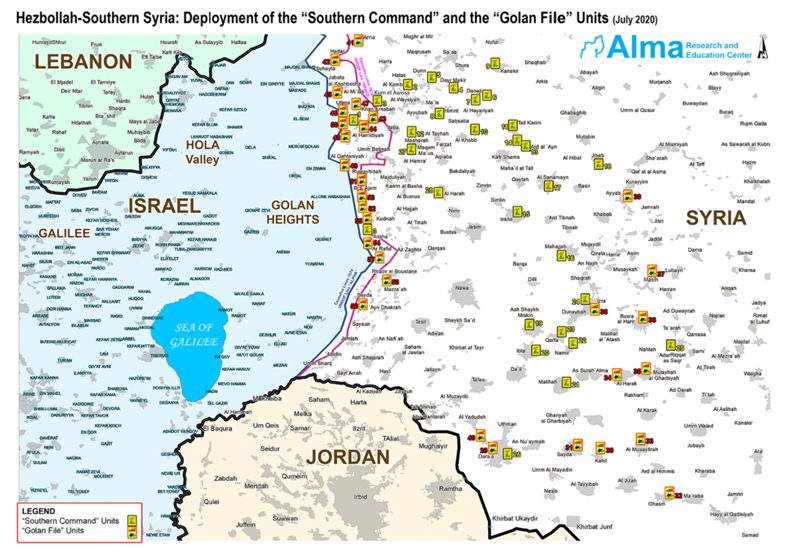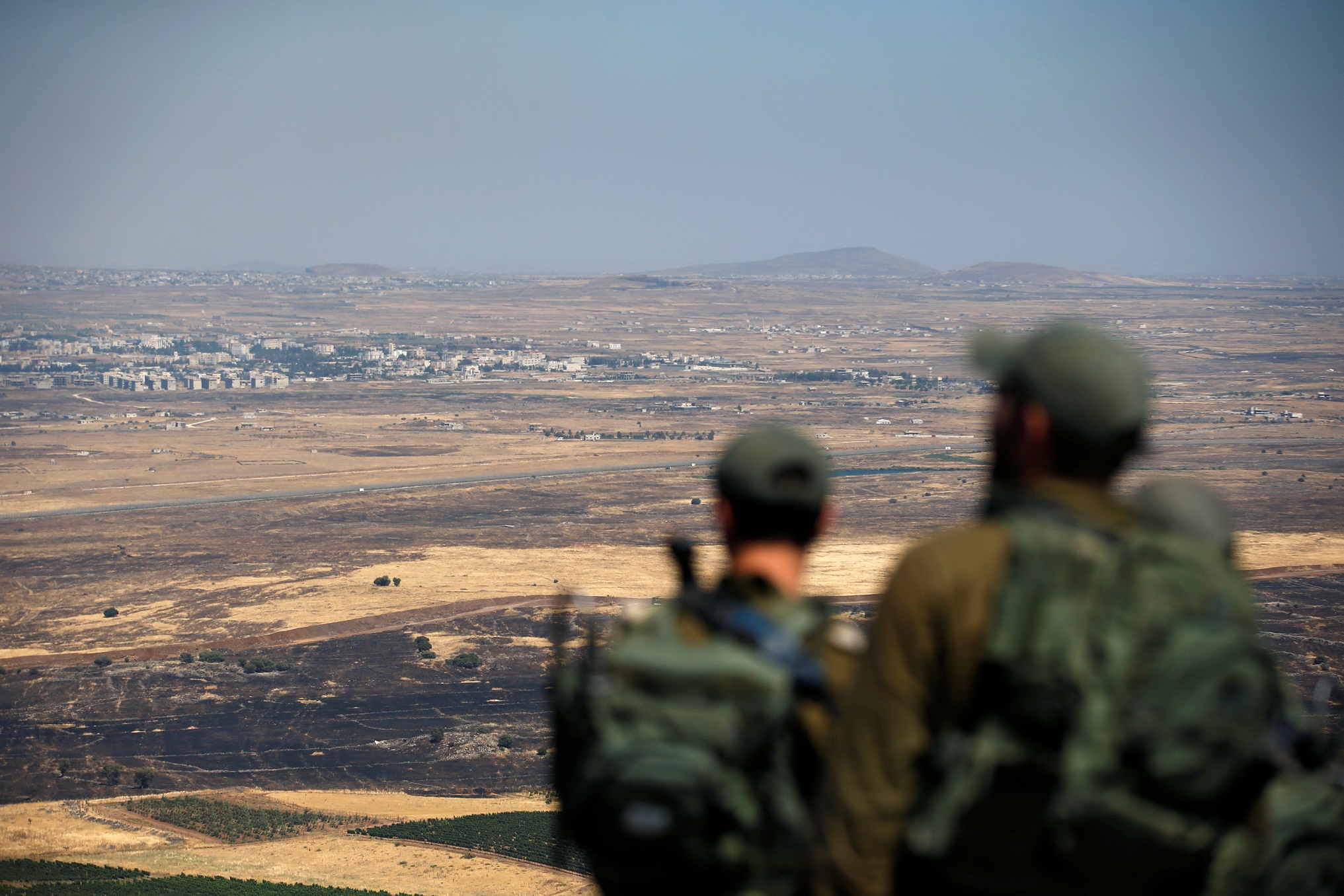Publications
INSS Insight No. 1414, December 16, 2020
Southern Syria is an Iranian “backyard” and a platform for attacks on Israel; for example, it could well serve as an option for revenge following the assassination of Mohsen Fakhrizadeh, head of the Iranian nuclear project. Iran is determined to continue the consolidation of its proxies in the area and enhance its local civilian and military influence. The current chaos in southern Syria stems from the Assad regime’s lack of effective control and the competing interests of the many actors that are active there: regime forces, local militias supported by Iran, Hezbollah, Russian forces, and the local Sunni and Druze population, which includes the remnants of the opposition to the Assad regime. This complexity mandates intervention by Israel in southern Syria, before Iran attains its objective and increases its influence in the region.
In the summer of 2018, the Assad regime regained control over southern Syria, following the signing of "reconciliation" agreements between the regime and the rebels, mediated by Russia. Russia also promised the United States, Israel, and Jordan that in return for their non-intervention, it would keep the Iranian forces away from the area. In contrast to the expulsion of residents from rebel-held areas to the north of the country following surrender agreements, most residents of the south, who had previously joined the rebel organizations, were not expelled to Idlib in northern Syria; they were recruited by local security forces obedient to the Assad regime in exchange for a promise that the regime would not wreak vengeance on them and would restore stability.
Since then, despite the Assad regime's nominal control of the area, three provinces in southern Syria are in effect subject to the rule and influence of various forces.
- Daraa, with about one million residents, most of whom are Sunnis, is subject to the rule of local leaders. These leaders, formerly members of the opposition to the Assad regime, now enjoy a degree of autonomy in managing daily life. They are supported by forces from the 5th Corps, and especially the 8th Brigade, established by Russia as a unique framework in the Syrian army's order of battle. The province includes a limited presence of Assad regime elements, which are reinforced by additional forces, depending on the situation, for example the deployment of units of the 4th Also active in the area are local defense militias supported and trained by Iran, together with units from the 313th Brigade founded in a separate framework in the Syrian army under Iranian influence and control in competition with the 5th Corps, which was established under Russian influence.
- Quneitra in the west, with about 90,000 residents, mostly Sunnis, features a more prominent regime, based on the 1st Corps of the Syrian army and Hezbollah presence.
- Suwayda in the east, with about 500,000 residents, mostly Druze, is under the control of local Druze groups (among them the al-Karama forces). Despite the Druze dominance, this province features a growing presence of pro-Iranian groups, mainly the National Defense Forces. The Assad regime is assisted by militias supported by Iran in order to create division within the Druze community and crush the aspirations for autonomy in the Suwayda and Jabal Druze theater.
The process of militarizing residents of the area and the increasing number of power centers have given rise to a fragile balance of power in southern Syria, featuring high levels of violence, armed skirmishes, poverty, and instability.
The Russian-Iranian Competition
The prevailing dynamic in southern Syria in recent months and the frequent clashes between groups under Iranian influence and those affiliated with Russia indicate growing competition for influence between Russia and Iran and reflect those actors' conflicting interests in the region, despite their partnership in the pro-Assad coalition.
Iran aims to strengthen its influence and consolidation in Syria and to deepen the grip of its proxies in the country by means of profound and multi-faceted penetration of the Syrian systems – defense, economy, education, society, culture, and religion – while gaining control of critical infrastructure, supporting pro-Iranian militias, engaging in Syrian military buildup, and promoting an ideological and demographic transformation. Furthermore, Iran is anchoring its presence in the southern Syrian provinces close to the Israeli border in order to create an additional front of friction and conflict with Israel through its proxies. Iran bribes local parties and arouses internal tensions in order to damage the social fabric and buy the loyalty of local groups, while at the same time disseminating Iranian regime ideology.
However, the United States policy of "maximum pressure" on Iran, continual Israeli attacks, and competition between Iran and Russia have slowed the pace of Iran's consolidation and forced Tehran to change the nature of its deployment in southern Syria, despite its determination to strengthen its grip in Syria. In the past, Shiite militias from outside Syria operated in the area. Today, however, Iran relies on local groups – homeland defense forces and local defense militias that it recruits, equips, and trains; Syrian army units under Iranian influence (among them the 4th Division, under the command of Maher al-Assad); and especially Hezbollah. Two main Hezbollah groups are currently active in southern Syria: the Southern Command, which includes Hezbollah officers as advisers and supervisors in the Syrian army, and the Golan File Unit under direct Hezbollah command, which is establishing terrorist cells comprising local Syrians. Hezbollah is also a partner in Iranian activity in southern Syria, which goes beyond the military aspect, including the operation of a drug smuggling network, land purchases, and the provision of basic goods and services, in order to extend its influence and earn support in local public opinion.

Russia, on the other hand, seeks to stabilize the situation in southern Syria. Russian military elements demonstrate their presence and activism in the area, and are in contact with the various forces there. In general, Russia wants to achieve stability in Syria, while upholding the central regime headed by Assad, in order to convert its military success in the civil war into a political achievement, economic benefits, and long-term influence in the country, and in the Middle East in general. Although the southern provinces are officially under the control of the regime in Damascus, it appears that Russia is still considering a formula of federal local control, in accordance with the Russian model, which appears in the draft constitution it proposed in early 2016, based on the principle of "decentralized power."
At the same time, Russia is interested in maintaining proper relations with Israel and preserving the strategic coordination between them in the Syrian theater. Russia has therefore conveyed its willingness to carry out its promise to the United States and Israel by removing the Iranian presence to a distance of 80 kilometers from the border with Israel. Already in 2018, Russia established the 8th Brigade, affiliated with the 5th Corps, after it took an active part in the process of regulating the status of the rebels in the Daraa province. Today, this brigade acts inter alia to limit the penetration of Iranian proxies in the south, and also frequently confronts with the Syrian regime's forces, especially the 4th Division. One of the interesting local leaders is 38 year-old 8th Brigade Commander Ahmad al-Oda, from the town of Busra al-Sham, who began as a rebel soldier fighting against the Assad regime. His influence has recently expanded from the Daraa to the Suwayda province. Despite his subordinate position to the 5th Corps directed by Russia, he maintains a degree of independence, and openly expresses his opposition to a foreign presence on Syrian soil and his hostility toward Assad and the Iranians.
The large number of actors in southern Syria and competition for influence between Russia and Iran create a dynamic decentralization of influence in the area. The local population prefers joining the element it perceives as a powerful force, and especially that provides defense and civilian assistance. Despite Iran's determination to strengthen its grip on the area, it is now forced to downsize its activity there, due to budgetary constraints and Russia’s restraining measures. Russia itself, however, has only limited ability to curtail Iranian consolidation efforts in southern Syria, let alone expel Iran and its proxies from the area. The Assad regime has in effect adopted a "passive neutrality" in the competition between Russia and Iran, and allowed the local struggles between the various actors in order to let them wear each other out, and to prevent the emergence of a single dominant power in the area, particularly at the present time, when southern Syria is low on the regime's list of priorities.
Significance and Recommendations for Israel
Since the onset of the civil war in Syria, Israel has remained on the sidelines, and has avoided intervention in the struggle for control in southern Syria, only conducting military action against concrete threats in the area. With the return of the Assad regime to southern Syria, Israel terminated Operation Good Neighbor, which was designed to provide humanitarian aid to the local population, mainly in communities close to the border in the Golan Heights, to attain stability and prevent terrorist actions against Israel.
Israel’s policy of non-intervention, exclusive of overt and covert attacks aimed at preventing terrorism and the transferal of advanced weaponry from Iran to Hezbollah via Syria, has enabled Iran, while fighting at the side of the Assad regime, to take advantage of the opportunity to build military capabilities against Israel, and to consolidate its overriding influence in Syria for the long term. Iran has thus been able to establish another front against Israel, in addition to the Lebanese front, for use in times of war or escalation. Once Israel realized this state of affairs, it was forced to operate a military response to the Iranian consolidation, while at the same time relying on Russia to remove the Iranian military presence from Syria and design a future arrangement comfortable for Israel. Here, however, Moscow has not yet delivered on this promise. On a related note, the Israeli policy in southern Syria is essentially another version of its policy of non-intervention that has enabled the Iranian-Shi'ite axis to build military outposts and terror cells in the south aimed against Israel.
In order to prevent Iran from using its proxies to create a border of friction in the Golan Heights marked by terrorism and high tension, Israel should take advantage of the weakness of the Iranian-Shiite axis, including the Assad regime. It can use its mechanism for coordination and deconfliction with Russia to adopt a proactive policy in southern Syria and attack the Iranian proxies there, including Hezbollah forces. At the same time, Israel should strengthen local forces, both Sunni and Druze, and forge connections by means of humanitarian aid – food, fuel, and health services – with elements in the local population that oppose the regime. This will create an "island of Israeli influence," thereby disrupting the drive to consolidate the Iranian and its proxies presence in southern Syria.



